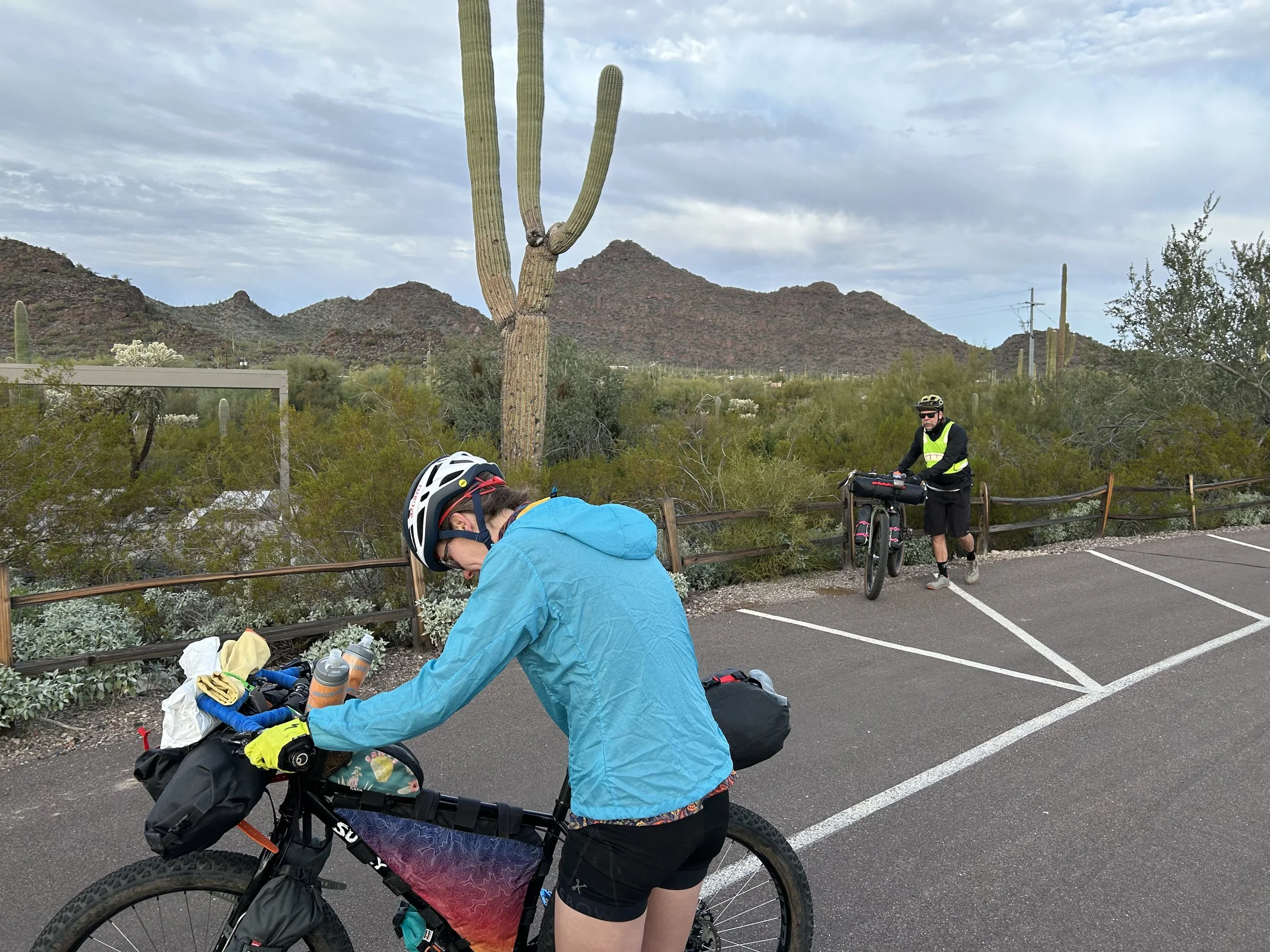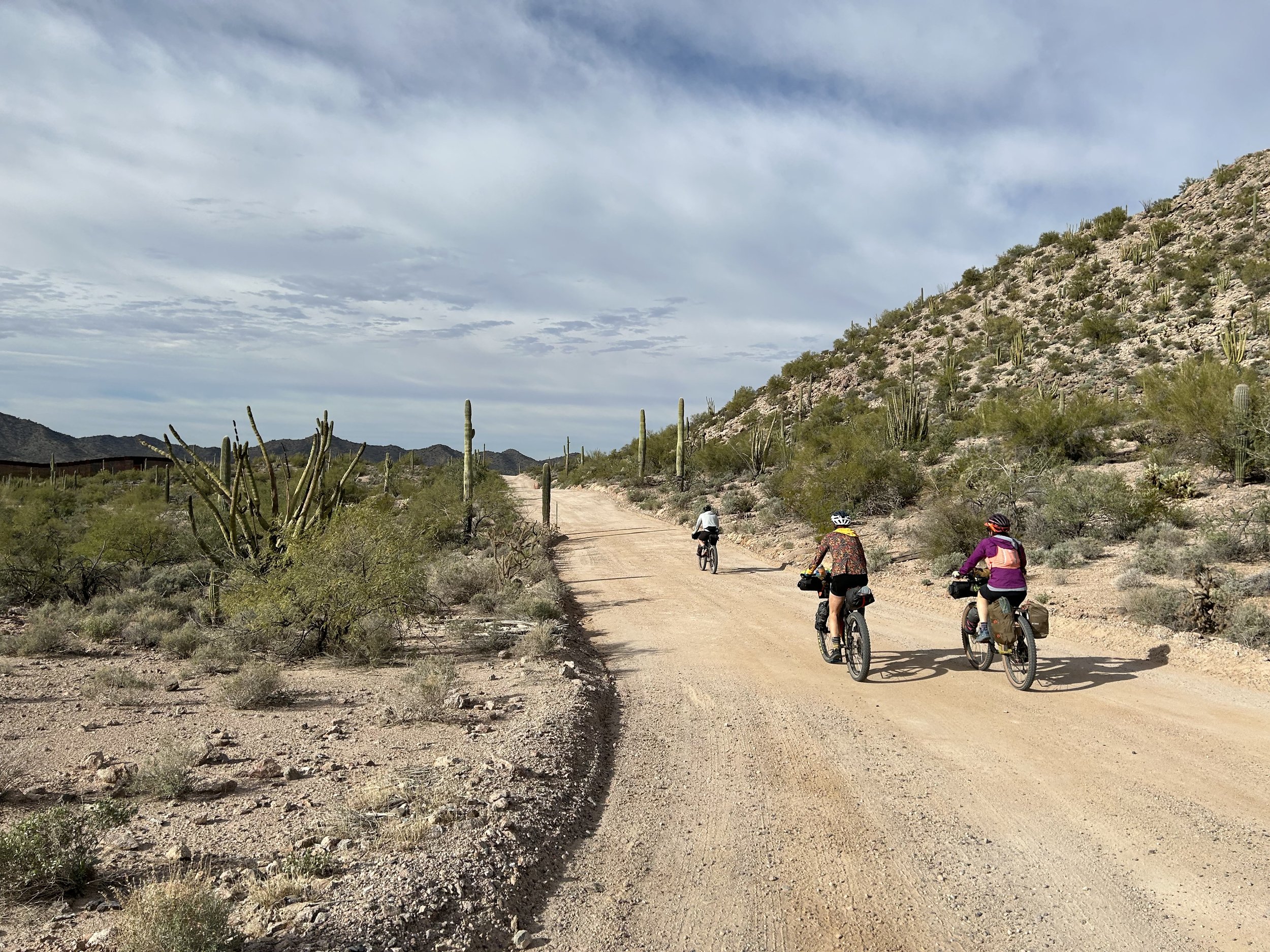El Camino del Diablo - Day 1 - Organ Pipe Cactus National Monument and Papago Well
Date: December 27, 2022
For five years this route has been on my mind. The El Camino del Diablo is a historical travel corridor that traditionally started in Sonora, Mexico and extended to Yuma, Arizona. The Devil's Highway has been and still is a remote swath of Sonoran Desert, undeveloped, and miles from any paved highways or towns. Contemporarily, it extends from just southwest of Ajo, AZ to Yuma, AZ. It's traveled predominately by people recreating by overlanding, Border Patrol, or immigrants heading north. A few years back, Bikepacking.com posted the El Camino del Diablo Bikepacking Route which follows the current route save for a stint at the end that winds up and through the Gila Mountains by Fortuna Mine before making its way into southeast Yuma. Janna and I have wanted to ride it for years, but (a) conditions haven't been excellent over some of our winter breaks, (b) we couldn't find anyone to join us, and (c) we were tied up with other obligations.
After Kate joined us to bikepack the Sky Islands Odyssey again this past autumn, we ran the El Camino del Diablo by her. She said Dan and her were both in. With time off secured and winter break arrived, Janna and I packed up our plus bikes and headed down to the border. We drove to Yuma where Kate met us. We left her car with permission at the hotel we planned to finish at, piled into our vehicle, and drove across the state to Organ Pipe Cactus National Monument.
The four of us camped at Twin Peaks Campground in Organ Pipe Cactus National Monument the night before. While the rest of the state was wrestling with snow and plummeting temperatures, we walked around in shorts past twilight and enjoyed the warmth of the bottom corner of AZ. We had decided to make an alternate to the start of the route by riding out from Organ Pipe Cactus NM down to the border wall and taking the Puerto Blanco Drive down and around to Quitobaquito Springs and then up to intersect the route-official on the north-end of the park. We secured permission from Organ Pipe to leave our car at the Visitor Center. This would allow us to bike one of my favorite rides in the area again in addition to checking in on the Springs. Ever since the end of the Trump presidency and the surge of wall-building that coincided, I've been super concerned with the state of that unique water habitat.
Morning came with the promise of golden light and perfect temps. We packed up the campground, bundled the vehicle at the Visitor Center, and pushed off down the highway towards the international border. Light spread thickly through cirrus cloud across the lush vegetative landscape where saguaros mixed with creosote, palo verde, mesquite, senitas, and the iconic organ pipe cactus found only here at this southern tip of the United States. The shear biomass of plant life was stunning, accentuated further by the copious winter rains this year that left the park brimming with swollen greens amidst the landscape. We veered left Puerto Blanco and soon were greeted with the grated desert-slice of the wall. It still shocks me how much this area has been impacted by the push to build it. Years ago, Janna, Darren, and I rode this route when there was no wall (only vehicle barriers), and desert peaks along the southern border were spiked and rounded by thousands of years of erosion and biotic breakdown. Now, a severing concrete road chunneled through each range met along the border along with the stories-high fence.
We rode along the border wall for miles stopping to take copious photos of unique cacti and the wall itself which, regardless of feelings, trained the eye to draw along and upon it. It was massive, scraping landscape, and linearly disrupting the natural flow of the Sonoran's plant and animal communities. We sped along the metal barricade all the way to Quitobaquito Springs. Here, I was stunned to see a sterile water source. Instead of the rich pond with feeding spring water filled with Sonora mud turtles and Quitobaquito pupfish, I instead found a murky green water-soup devoid of any plant life in its littoral zone. A single pied-billed grebe swam in the middle. The edges had been plowed and artificially evened. The water level had dropped from groundwater pumping served to mix concrete to build the wall. I walked the circumference of the spring, crestfallen for the barren shore. I walked to wear the spring fed into the reservoir and found that there was a single deep pool, clear, and filled with pupfish.
After that, we jumped on our bikes and headed to the northern boundary of the park to intersect with the El Camino del Diablo's official route. We poured onto a desert sand wash and wound up through saguaro swollen from winter rains. The ground firmed up and swept west from the southern arc of the Growler Mountains. We rode across the massive alluvial plans smoothed flat with sediment sand and silt. At early afternoon, we reached the boundary between Organ Pipe Cactus NM and the Cabeza Prieta National Wildlife Refuge. The Cabeza Prieta is famous for its population of Sonoran pronghorn, a highly endangered species that are 3.5 feet high at the shoulder, light in color, and evolved to live in this cactus-scape (quite different from the grassland/savannah habitats of their common western relatives). We headed down the El Camino-proper and started fishtailing in the first sand of the trip. It wasn't unmanageable with our 2.8 inch tires and we grinded through. We passed by a border patrol remote outpost and several trucks with military personnel drove by us heading in the opposite direction.
By late afternoon we rounded Sheet Mountain, passed up Cholla Pass, and came into the Agua Dulce Mountains. The splinter of light through clouds washed the landscape in sepia which steeped it in additional beauty to my mind. Saguaro stood stark against beige-blasted peaks and spindly ocotillos casting sharp shadows around us. The sun drifted west and hit us full on as we approached Papago Well and its designated campground - our intended camp location for the night.
When we spoke to the rangers at Cabeza Prieta NWR prior to the trip, they highly suggested we stay both at Tule Well and Papago Well campgrounds on our rides. We expected high/frequent migrant crossings in the night, and the rangers confirmed it. They told us not to travel after dark and to stay in the campgrounds. As the campgrounds were known to migrants and coyotes, our presence there would be better suited to expectation as opposed to dispersed-camping elsewhere along the route and being stumbled upon in the night. Cabeza Prieta NWR said they could not confirm nor deny water availability at either of these wells. Thus, we started the day's riding with 8+ liters each just in case there was no water to be found at the well. However, that concern was allayed because both wells ended up being brimming with crystal clear water and easy to locate/use spigots. It was super obvious to us all that both Papago Well and Tule Well were very prominent and singular water sources with miles of dry land on either side. Any person needing water would zero in on these locations.
Papago Well was located about 200 years from the camping area. The campground was a spread of flat-packed-sand with a small tent signage. There were picnic tables per each "site." A truck was parked at the end of the area so we headed to the opposite side where two tables were close to each other. A large dry wash bisected the road and land nearby. It was lined with thick mesquite. We took a look and found that it was filled with foot tracks and abandoned clothing - a definite corridor for people moving across the land. We setup camp and prepared for a wet morning the next day. A large weather system would move an atmospheric river of precipitation across the southwest by tomorrow morning leading to snow dumped in the high country and rain in the low deserts. Clouds quickened at dusk. A sky-blue-pink sunset boiled rosy in the growing clouds and then burst after hesitation in a smear across the sky spectacularly. We ate dinner and took tons of photos of the gathering night.
As day waned into the folds of dark, we unbundled our gear from our bikes and packed them under the vestibules of our tents to avoid any possible loss of gear from storm or person in the night. A border patrol drone began buzzing the surrounding Papago Mountain. I saw a light on a peak flash on and then off several times. The neighboring camper in the truck came over to talk to us before he went to bed. We retired to our own tents as humid air kept the nighttime temps well-moderated. An hour or two later in the early winter dark, just on the edge of sleep, I suddenly heard a very loud whistle pierce the night. I shot bolt-awake with adrenaline. I exited the shelter quickly, urinated, and listened hard to the night. Nothing. I climbed back inside the tent and laid down, unsure as to whether I had imagined the sound on the verge of sleep. Then, not 5 minutes after turning off my light, a series of whistle and responses started from the wash to our right followed by a two-blast whistle from the middle of the campground as people communicated with each other. I lay very awake. Dan would later report hearing people walking by our tents in the night. I struggled to sleep well after that. Around 2 am, the weather front moved in strong with a blast of winds that zoomed across the campground. As our shelter flapped in the wind gusts, I exited to tighten all tie-outs and could see a mélange of roll clouds bellowing in the night sky. Tent more secured, I crawled back inside and slept until dawn.















































































































































































































































































